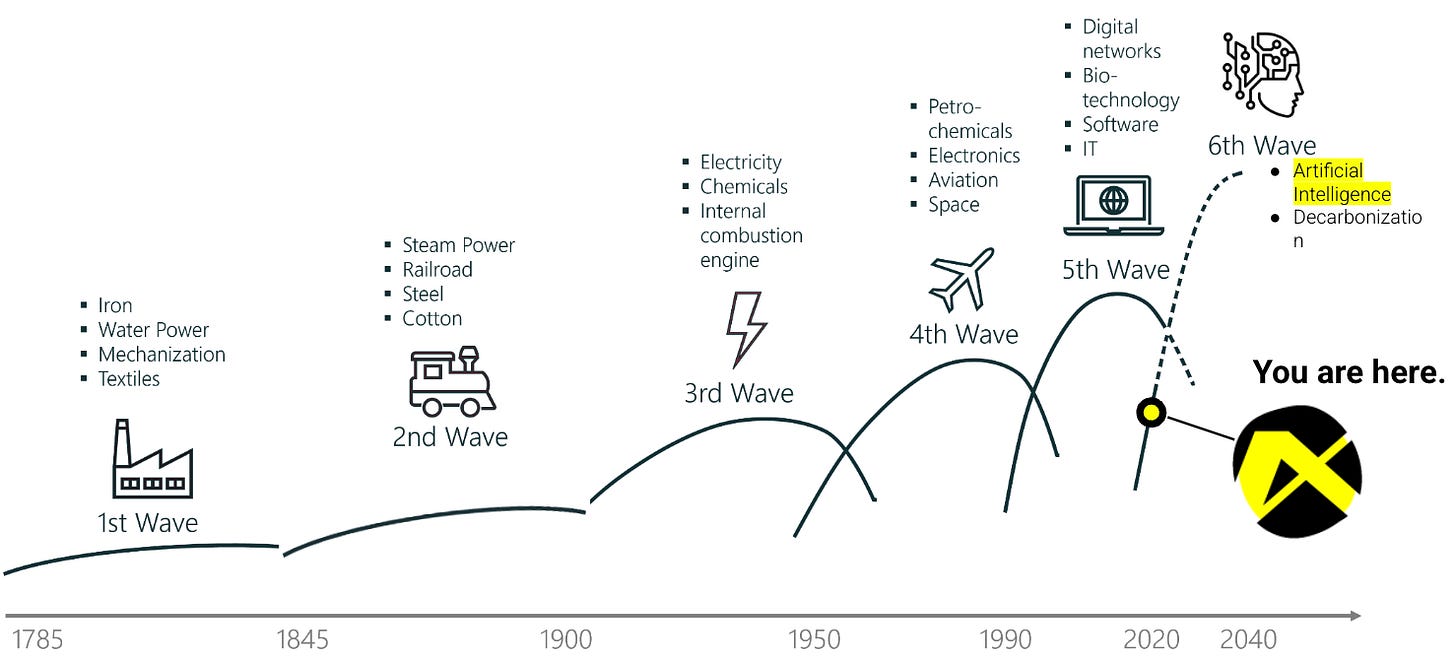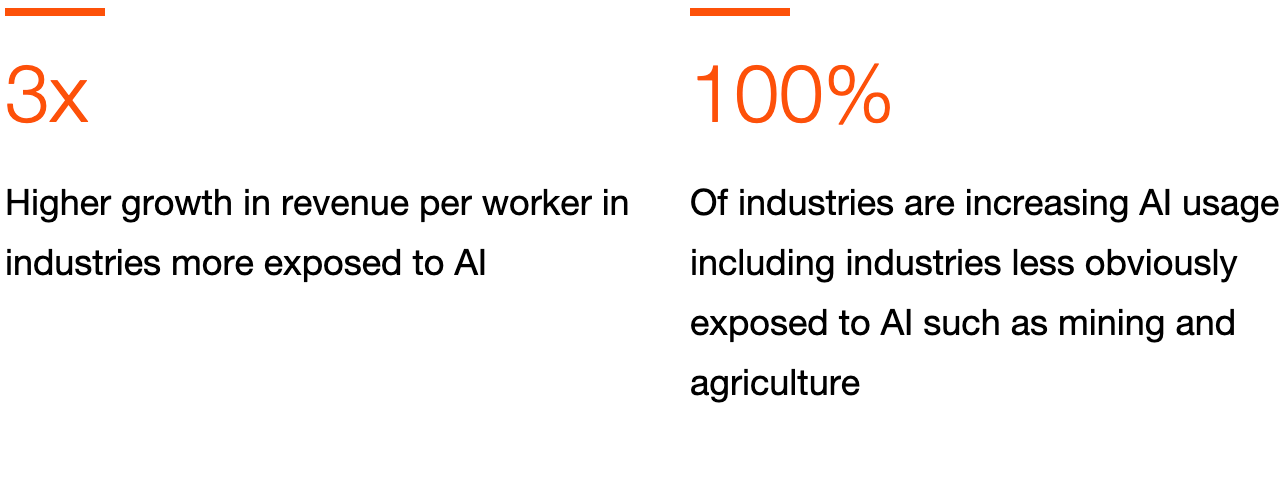🦾 The AI Revolution: Your Once-in-a-Lifetime Chance to Forge the Future
In an era of unprecedented technological upheaval, will you be the architect of tomorrow or merely a passenger? This is the defining moment to build the world we want to live in.
The pace of AI advancement isn't just fast; it's a tsunami, fundamentally reshaping industries and economies at an unprecedented rate. Just months ago, executives compared AI to a 'super-efficient intern,' but recent tech earnings show this 'intern' is rapidly ready for a 'more substantial corporate role,' as copious AI investment transforms into tangible revenue and real-world results, as highlighted by Al Jazeera on May 1, 2025.1 Productivity growth in AI-exposed industries has nearly quadrupled (from 7% to 27%) in just two years (2022-2024) since GenAI's proliferation, according to findings anticipated in the PwC Global AI Jobs Barometer, June 2025 that came out two days ago.2
AI is becoming a new economic engine. Experts predict AI will boost the global economy by an astonishing $4.9 trillion by 2030, up from $1.2 trillion in 2024, as discussed by allwork.space in June 2025.3 PwC further suggests AI could add 15 percentage points to global GDP by 2035, on par with 19th-century industrialization, as stated in their April 2025 press release.4 While these forecasts are staggering, this transformative potential won't materialize on its own. It requires bold action and relentless implementation to bridge the gap from prediction to prosperity.
Who, then, will be the architects of this AI-driven future?
1. The Big Problems in This World Have Always Been Solved by Entrepreneurs
As the renowned economist Joseph Schumpeter5 profoundly argued, entrepreneurs are the true engines of progress, relentlessly driving what he termed "creative destruction." Schumpeter defined the entrepreneur's unique function as "to reform or revolutionize the pattern of production by exploiting an invention or, more generally, an untried technological possibility." This sets them apart from the mere manager.

Unlike the manager, the entrepreneur is the visionary who innovates and disrupts, introducing "new combinations"—novel products, revolutionary methods, or entirely new markets. This dynamism, Schumpeter asserted in his seminal work, Capitalism, Socialism, and Democracy, is the very "essential fact about capitalism."
Our reality has been built by these relentless builders, daring to solve problems and create opportunities where none existed. The future, especially one as fundamentally reshaped by AI as ours, will be no different. It will be built by those who step into the entrepreneurial driving seat, not content to be passengers.
“AI will be the most profound innovation and one of the largest investment opportunities in human history.” - UBS Research, 2024

As we stand on the precipice of profound change, it's vital to recognize that history moves not just linearly, but in grand, overarching cycles often known as Kondratieff Waves or Supercycles. These long-term economic shifts, typically spanning 40-60 years, are driven by fundamental technological breakthroughs that redefine industries and societies, as detailed by Investopedia on Kondratieff Waves.6 Crucially, these transformative innovations don't emerge from thin air; they are primarily conceived, championed, and scaled by audacious entrepreneurs. This journey of innovation is visually represented in the timeline below:
From the dawn of the First Wave, propelled by the widespread application of steam power where James Watt's improved steam engine revolutionized industry around 1785.7
To the Second Wave's Age of Steam and Steel marked by George Stephenson's pioneering work with steam locomotives in the 1840s and the expansion of railroads.8
The Third Wave, commencing around 1900, saw the rise of electricity, chemicals, and the internal combustion engine, largely sparked by visionaries like Thomas Edison, whose inventions in electricity and lighting laid foundational infrastructure.9
The Fourth Wave, beginning mid-20th century, was shaped by petrochemicals, electronics, and aviation, heavily influenced by pioneers like William Shockley and the invention of the transistor, which underpinned the entire electronics revolution.10
Then came the Fifth Wave in the 1990s, the age of digital networks, software, and the internet, epitomized by figures like Steve Jobs, whose innovations in personal computing and digital ecosystems transformed how we connect and create.11
Today, we find ourselves at the cusp of the Sixth Wave, characterized by the immense power of Artificial Intelligence and the urgent drive towards Decarbonization. This new era, much like those before it, will be defined by a fresh generation of entrepreneurs, continuing the legacy of shaping our reality through bold creation.
2. The AI Acceleration - What's Driving It?
This section dives into the core technological advancements fueling the AI explosion.
1. Miniaturization and Efficiency
The cost of querying an AI model achieving GPT-3.5 equivalent performance (64.8% accuracy on MMLU12) dropped from $20 per million tokens in November 2022 to a mere $0.07 per million tokens by October 2024 (Gemini-1.5-Flash-8B), a >280-fold reduction in ~18 months, as highlighted in the Stanford AI Index 2025.13 The smallest model achieving >60% on MMLU went from 540 billion parameters (PaLM in 2022) to 3.8 billion parameters (Microsoft's Phi-3-mini in 2024) – a 142-fold reduction in over two years, also noted in the Stanford AI Index 2025. This makes sophisticated AI more deployable on less powerful hardware.

2. Performance Leaps
In 2024, performance on demanding benchmarks like MMMU, GPQA, and SWE-bench sharply increased by 18.8, 48.9, and 67.3 percentage points respectively, according to the Stanford AI Index 2025. This signifies rapid improvement in AI's ability to handle complex tasks. Beyond chatbots, AI agents can now initiate, plan, and complete multi-step tasks with minimal human intervention. This capability is poised to revolutionize workflows across industries, as discussed by Trio Dev in April 2025.14

Mark Zuckerberg recently reiterated that Meta's AI will be able to code as well as a mid-range software engineer sometime this year. Furthermore, new models like Writer's Palmyra X5 can process problems equivalent to 1,500 pages of text — roughly Isaac Asimov’s I, Robot six times over — more cheaply than rivals like OpenAI's GPT-4.1, demonstrating remarkable leaps in efficiency and capability, as reported by the Financial Times (via Al Jazeera) on May 1, 2025.15
3. Investment Tsunami
Global VC investment in AI companies hit record levels in 2024, exceeding $100 billion, an over 80% increase from $55.6 billion in 2023. Nearly 33% of all global venture funding was directed to AI companies, according to Mintz, March 2025.16
Major cloud vendors (AWS, Azure, Google Cloud) are collectively planning to allocate over $325 billion in 2025 to support data center growth and AI initiatives, demonstrating massive infrastructure investment, as referenced by Morningstar on June 2, 2025.17
Global venture capital funding for generative AI alone reached approximately $45 billion in 2024, nearly doubling from $24 billion in 2023, also cited by Mintz, March 2025. This colossal investment is being backed by companies' direct experience: Bain & Company's survey found 95% of companies use generative AI, and most report their business is measurably better off. The average company budgeted $10 million for AI spend by the end of last year, twice what was initially penciled in around the beginning of 2024, as reported by Artificial Lawyer, citing Bain & Company, on May 15, 2025.18 Tech giants are leading the charge, with Meta, for instance, raising its estimated capital expenditure for the year to potentially hit $72 billion, according to Al Jazeera on May 1, 2025.
3. AI's Tremendous Impact on Businesses and Economies
This section details the concrete ways AI is reshaping industries and economic landscapes.
1. Productivity Powerhouse
Industries most exposed to AI saw productivity growth nearly quadruple (from 7% to 27% from 2018-2024), according to the PwC Global AI Jobs Barometer, June 2025.19 AI is making workers more valuable and productive. The data shows job numbers are rising even in roles considered most automatable, largely due to augmentation where AI helps humans perform better, as found in the PwC Global AI Jobs Barometer, June 2025 that came out Tuesday.

AI boosts software developer efficiency by 21%, speeds up professional writing by 40%, and increases call center productivity by 14%, according to the World Economic Forum, May 2025.20 This isn't just theory; it's showing up in earnings.
Meta is using homegrown AI models to make ads on Facebook more lucrative, boosting Instagram user engagement by about 6% longer than a year ago. Microsoft's Azure cloud business saw 33% year-on-year revenue growth, with AI services accounting for half of that increase. Even Amazon's AI offering, though smaller, is in the billions of dollars and growing in triple digits.
2. Labor Market Transformation
Jobs requiring AI skills offer a significant wage premium, with the average hitting 56% in 2025, up from 25% last year as mentioned already. These jobs also continue to grow faster than all other jobs, as reported by the PwC Global AI Jobs Barometer, June 2025. The skills sought by employers are changing 66% faster in jobs most exposed to AI, according to the same PwC report21, emphasizing the need for continuous upskilling.
While the broader economic picture suggests job creation through augmentation, the reality of job displacement is very real and immediate, particularly for certain roles. Dario Amodei of Anthropic, for instance, has stated he could see unemployment spike to 10% to 20% in the next couple years from the current 4%, expecting a 'mass elimination of jobs across tech, finance, legal, and consulting,' with entry-level workers hit hardest. He argues AI companies and governments need to 'stop sugarcoating what's coming,' as discussed on the All-In Podcast (Episode: The AI Doomer Ecosystem) on May 29, 2025.22 While some dismiss such dire predictions as 'doomerism' or 'sensationalist' for headline grabbing or political agendas, there's broad agreement that jobs like cab drivers are unlikely to exist in 10 years, and we are seeing direct evidence of replacement now.

Indeed, companies like language app Duolingo are stopping the use of contractors for jobs AI can do, and e-commerce giant Shopify has stated it won't hire if AI can perform the human's job, illustrating a tangible shift towards direct human replacement in specific functions, as reported by LeadDev on May 2025, citing internal announcements.23 Nevertheless, the World Economic Forum predicts net job growth of 7% of total employment due to AI, as cited in a Business at OECD paper, February 2025.24
3. Operational Efficiency & Innovation
AI is revolutionizing operations through task automation, process optimization, and predictive maintenance, as discussed in an MDPI paper, 2024.25 Companies like Amazon use AI to predict demand and optimize inventory, enabling faster delivery times. AI enables highly personalized customer experiences at scale through recommendation systems and AI chatbots for customer support.
4. New Business Models & Industries
AI is not just optimizing existing processes; it's enabling entirely new ways of working and the formation of new "domains" that cross traditional sector lines, according to PwC, April 2025.26 Examples include advanced AI for scientific discovery, healthcare diagnostics and drug discovery, and intelligent real-world overlays with AI + AR, as highlighted by Trio Dev, April 2025 and the AI in AR/VR market size projected by The Business Research Company, citing Statista, April 2025.27

4. Opportunities for Founders – The New Landscape for Builders
The Shifting Talent Tide: From Hyperscalers to Hyper-Growth Startups: The traditional career path of joining a major tech company is undergoing a significant re-evaluation. While hyperscalers and tech giants are making massive AI infrastructure investments – as mentioned with over $325 billion earmarked for data center growth and AI initiatives in 2025 alone – their hiring strategies have shifted. Microsoft, for instance, has even frozen some near-term data center self-build projects, according to SemiAnalysis in April 2025.28 Recent analysis suggests that Big Tech's hiring plunge isn't solely a direct result of AI replacing jobs, but rather a correction from prior over-hiring and macroeconomic pressures. In fact, many layoffs at large incumbents have targeted entry-level and non-technical roles, with new grads accounting for just 7% of Big Tech hires in 2024, down over 50% from pre-pandemic levels, as per AIM Research on June 4, 202529 and corroborating analysis by SignalFire's State of Tech Talent Report 2025.30 This environment, combined with the increasing sophistication of AI tools taking over routine tasks, means companies are prioritizing roles that deliver high-leverage technical output, often requiring more experience.
However, this dynamic is creating a powerful new opportunity for founders and for talent looking for impact and ownership. The 'talent reshuffling' is real: skilled professionals, including elite AI researchers and engineers, are actively leaving established companies in favor of startups. This movement is driven by a desire for:
greater impact
direct ownership
and the ability to escape the bureaucracy
and slow decision-making often found in larger organizations, as detailed by Coastal Recruiting in March 2025.31
Historically, there has been a sevenfold increase in talent working in venture-backed firms since 2015 in Europe, indicating a growing preference for entrepreneurship and early-stage growth environments over traditional corporate structures, according to Dirox in January 2025.32
While the venture capital landscape has seen some overall flattening (excluding mega-rounds like OpenAI's $40 billion raise in Q1 2025, which skewed global figures), late-stage and AI-focused investments continue to surge. More importantly for founders, while early-stage and seed funding deal counts have shown some recent caution, the capital is flowing towards truly impactful and well-conceived AI ventures, as analyzed by Crunchbase News on April 21, 2025.33
For instance, the U.S. sees an average of 4.4 million startups added annually (based on 2017-2022 data), with the highest venture capital deals going to AI and big data, representing approximately 25% of all VC deals, as indicated by Founders Forum Group's 2024-2025 statistics.34
This means the environment is ripe for those with strong ideas and the drive to build, offering options and equity that large companies might not. For students and aspiring founders, this is the most crucial time to leverage this shift: don't just observe; build.
Focus on Augmentation, Not Just Automation: While the rapid advancement of AI is now directly leading to job replacement in some areas, the initial "AI intern" phase, where AI augments human capabilities, remains a powerful starting point for innovation. Look for opportunities where AI can act as a "copilot" to existing professionals, as suggested by allwork.space, June 202535 and demonstrated by Vanguard's AI partnership in May 2025.36 Think about augmenting doctors, lawyers, teachers, and creatives. AI can boost productivity for less-experienced and lower-skilled employees, narrowing skill gaps, according to IZA World of Labor, February 2025.37
How can your solution empower a broader workforce?
Vertical AI Solutions: Instead of broad AI platforms, consider specialized AI solutions for specific industries. This allows for deep domain expertise and solves precise pain points. Examples: AI for drug discovery (Insitro, Recursion, DeepMind), AI for agricultural optimization, or AI for bespoke legal document generation.
Agentic AI: This is a rapidly emerging area. How can you build AI systems that can independently initiate, plan, and execute multi-step tasks? This could disrupt entire workflows.
Edge AI: Deploying AI models on local hardware devices for increased control and data privacy. Consider applications in security, healthcare, manufacturing, robotics, and wearables.
AI for Scientific Discovery and Healthcare: The potential here is immense – from accelerating drug discovery to enhancing diagnostics and personalized patient care (Morningstar, May 2025).
Sustainable and Ethical AI: As AI goes mainstream, users and investors are demanding transparency and ethics. Build solutions with responsible AI principles at their core. This isn't just good practice; it's a competitive advantage.
Democratizing AI Access: Not everyone has deep technical AI knowledge. Tools that allow non-technical founders to leverage AI (e.g., through no-code/low-code platforms, intuitive APIs) will be highly valuable.
AI-Powered Automation & Personalization: Automating operational costs by 20-30% (according to McKinsey, cited in Ardem.com, March 2025) and offering hyper-personalized experiences are no longer optional. Look for ways to integrate these deeply into your product.
Leveraging Voice-First and AR/VR: Voice AI is changing user interaction, with 50% of app searches predicted to be voice-based by 2025 (Juniper Research, cited by Demand Sage, May 2025). AI + AR is predicted to see significant market growth by The Business Research Company, citing Statista, April 2025. These areas offer rich ground for innovation.
Conclusion: Build Smart, Build Now
The AI revolution is here, and it's accelerating. For founders and students looking to make an impact, this isn't a time for hesitation. It's a call to action. Focus on:
Understanding the core technological advancements and their practical applications.
Identifying specific problems that AI can uniquely solve.
Building solutions that augment human capabilities and drive real productivity gains.
Prioritizing ethical considerations and building trust.
Staying agile and adaptable in a rapidly evolving landscape.
Understanding the broader geopolitical and ideological forces at play in the AI landscape, and advocating for policies that foster innovation rather than hinder it.
The future of business and economy will be AI-powered. The question is, will you be among those building it?
That’s my take - now over to you.
Drop a comment below and let’s trade notes.
Best,
Fab🥤
Sources
https://www.aljazeera.com/news/2025/5/1/meta-microsoft-report-strong-earnings-despite-trade-war-uncertainty
https://www.pwc.com/gx/en/issues/artificial-intelligence/ai-jobs-barometer.html
https://allwork.space/2025/06/from-japan-to-nigeria-ai-is-changing-what-work-means-and-who-gets-left-behind/
https://www.pwc.com/gx/en/news-room/press-releases/2025/ai-adoption-could-boost-global-gdp-by-an-additional-15-percentage.html
https://www.google.com/search?q=Schumpeter+Capitalism%2C+Socialism%2C+and+Democracy+pdf&sourceid=chrome&ie=UTF-8
https://www.investopedia.com/terms/k/kondratieffwave.asp
https://www.britannica.com/biography/James-Watt
https://en.wikipedia.org/wiki/George_Stephenson
https://www.biography.com/inventors/thomas-edison
https://history.computer.org/pioneers/shockley.html
https://www.biography.com/business-leaders/steve-jobs
https://paperswithcode.com/sota/multi-task-language-understanding-on-mmlu#:~:text=MMLU%20(Massive%20Multitask%20Language%20Understanding,identifying%20a%20model's%20blind%20spots.
https://hai.stanford.edu/ai-index
https://trio.dev/ai-startup-trends/
https://www.aljazeera.com/news/2025/5/1/meta-microsoft-report-strong-earnings-despite-trade-war-uncertainty
https://www.mintz.com/insights-center/viewpoints/2166/2025-03-10-state-funding-market-ai-companies-2024-2025-outlook
https://www.morningstar.com/news/globe-newswire/9461354/hyperscale-data-reports-219-million-in-assets-at-end-of-q1-2025-sells-minority-stake-in-private-pharmaceutical-company-for-465-million-as-part-of-company-streamlining
https://www.artificiallawyer.com/2025/05/15/business-spending-on-genai-doubled-in-2024-bain-survey/
https://www.google.com/search?q=https://www.pwc.com/gx/en/issues/transformation/ai-job-barometer.html
https://www.weforum.org/stories/2025/05/google-chief-economist-outlook-ai/
https://www.pwc.com/gx/en/issues/transformation/ai-job-barometer.html
https://leaddev.com/hiring/whats-really-behind-drive-first
https://www.businessatoecd.org/hubfs/website/documents/pdf/Education/Boosting%20Productivity%20and%20Business%20Growth%20The%20Role%20of%20AI%20Skills.pdf
https://www.mdpi.com/2078-2489/16/1/26
https://www.pwc.com/gx/en/news-room/press-releases/2025/ai-adoption-could-boost-global-gdp-by-an-additional-15-percentage.html
https://blog.tbrc.info/2025/04/ai-in-virtual-reality-and-augmented-reality-market-size-3/
https://www.google.com/search?q=https://www.semianalysis.com/p/microsofts-secret-15gw-data-center
https://www.google.com/search?q=https://aimresearch.co/market-industry/the-great-tech-layoff-lie-and-the-convenient-ai-scapegoat/
https://www.google.com/search?q=https://www.signalfire.com/blog/state-of-tech-talent-q1-2025
https://www.coastalrecruiting.co/blog/talent-reshuffling-in-startups-why-the-best-minds-are-moving-and-what-it-means-for-the-future
https://dirox.com/post/european-tech-2024-2025
https://news.crunchbase.com/venture/startup-investment-charts-q1-2025/
https://ff.co/startup-statistics-guide/
https://allwork.space/2025/06/from-japan-to-nigeria-ai-is-changing-what-work-means-and-who-gets-left-behind/
https://www.google.com/search?q=https://www.vanguard.com/about/newsroom/press-releases/vanguard-and-university-of-toronto-to-launch-ai-research-and-innovation-partnership-in-canada
https://wol.iza.org/articles/artificial-intelligence-and-labor-market-outcomes/long









